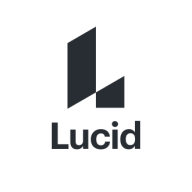

Find out in this report how the two Visual Collaboration Platforms solutions compare in terms of features, pricing, service and support, easy of deployment, and ROI.
| Product | Market Share (%) |
|---|---|
| Miro Business - Enterprise | 38.7% |
| Lucidspark | 4.7% |
| Other | 56.599999999999994% |

| Company Size | Count |
|---|---|
| Small Business | 18 |
| Midsize Enterprise | 4 |
| Large Enterprise | 10 |
| Company Size | Count |
|---|---|
| Small Business | 7 |
| Midsize Enterprise | 1 |
| Large Enterprise | 6 |
Lucidspark is a virtual whiteboard where teams can bring their best ideas to light. Collaborate in real time, no matter where you are. Lucidspark helps people organize notes and scribbles and turn them into presentation-ready concepts. When it’s time for next steps, teams can develop workflows and process documents to turn ideas into reality. Features include: integrations, infinite canvas, sticky notes, freehand drawing, chat, templates, timer, voting, and more.
With Lucidspark, you can not only brainstorm ideas as a team but then refine and organize those ideas to drive action. Features like assisted grouping and Lucidchart import/export help users turn ideas into plans and strategies.
Lucidspark is part of the Lucid suite, the only visual collaboration suite that helps teams see and build the future from idea to reality. Users can start ideating in Lucidspark and then seamlessly move to Lucidchart and Lucidchart Cloud Insights to complete the full project lifecycle and make their ideas a reality.
Miro is a collaborative online whiteboard platform that enables teams to work together remotely, brainstorm ideas, and visualize concepts. With its intuitive interface and extensive range of features, Miro has become a popular tool for remote teams, designers, and educators.
One of the key features of Miro is its vast library of templates and widgets, which allows users to quickly create various types of visual content such as mind maps, flowcharts, wireframes, and user journey maps. These templates provide a starting point for collaboration and help teams to structure their ideas effectively.
Miro also offers real-time collaboration, allowing team members to work together on the same board simultaneously. Users can leave comments, mention team members, and have discussions directly on the board, eliminating the need for lengthy email threads or separate communication tools.
The platform also integrates with popular tools like Slack, Jira, and Google Drive, making it easy to import and export content from other applications. This seamless integration enhances productivity and ensures that teams can work with their preferred tools without any disruptions.
Furthermore, Miro provides a range of interactive features that enhance collaboration and engagement. Users can add sticky notes, create voting sessions, and conduct remote workshops using Miro's built-in video conferencing capabilities. These features make it easy for teams to brainstorm ideas, gather feedback, and make decisions together, regardless of their physical location.
In addition to its collaborative features, Miro also prioritizes security and privacy. The platform offers enterprise-grade security measures, including data encryption, access controls, and compliance with industry standards like GDPR and SOC 2. This ensures that sensitive information remains protected and confidential.
We monitor all Visual Collaboration Platforms reviews to prevent fraudulent reviews and keep review quality high. We do not post reviews by company employees or direct competitors. We validate each review for authenticity via cross-reference with LinkedIn, and personal follow-up with the reviewer when necessary.